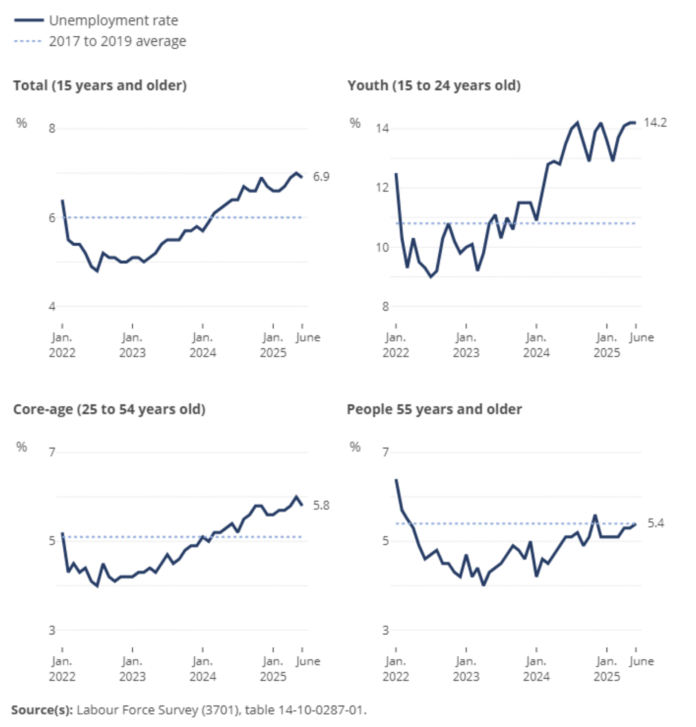Statistics Canada’s labour force survey, released this morning, showed the addition of 83,000 jobs in June—breaking a stretch of minimal employment growth since January.
The unemployment rate also edged down 0.1 percentage point to 6.9%, after reaching a near-decade high last month. Economists had expected it to hold at 7% or rise to 7.1%. The employment rate ticked up to 60.9%.
Youth employment remained a weak spot in the June data, however. The unemployment rate for returning students aged 15 to 24 rose to 17.4%—the highest for June since 2009, excluding the pandemic. Younger teens were hardest hit, with those aged 15 to 16 facing a 27.8% jobless rate, up 3.3 percentage points from last year.
Part-time positions accounted for the bulk of June’s gains, with an increase of 70,000 jobs. Employment also rose in both the private sector (+47,000) and public sector (+23,000).
Most of the gains were concentrated in wholesale and retail trade (+34,000), health care and social assistance (+17,000), and manufacturing (+10,000). The agriculture sector saw a modest decline of 6,000 positions, while employment was “little changed in other industries,” the agency noted.
Average hourly wages rose 3.2% year-over-year to $36.01, easing slightly from May’s 3.4% increase.
BMO’s Benjamin Reitzes was pleased with this morning’s data, but has a noticeable caveat: “One arguable blemish is that most of the gains were in part-time jobs. No matter how you slice things, this report is materially better than expected.”
Tariff threats and CPI risks expected to keep BoC on hold
Although this morning’s job numbers surpassed expectations, economists are viewing the data through a wider lens—one that includes recent tariff threats and broader economic risks.
RBC’s Nathan Janzen views this morning’s data as largely positive, though not enough to dispel the chill compared to last year—especially with recent tariff threats looming large.
“Canadian labour markets are still substantially weaker than they were a year ago with weakness concentrated in sectors and parts of the country more sensitive to international trade disruptions,” he wrote. “And trade risks remain with Canada added to a growing list of countries facing threatened new tariff hikes from the U.S. administration on August first.”
Reitzes, meanwhile, points to ongoing economic uncertainty as a check on this morning’s strong jobs data, which he believes may draw some skepticism. While he sees the economy as “hanging in there for now, pending the result of ongoing trade negotiations,” he doesn’t expect the Bank of Canada to act, given Canada’s sticky underlying inflation.
“Barring a sharp decline in underlying inflation in next week’s June CPI report (which looks unlikely), the strength in today’s jobs data and the recently heightened uncertainty on the trade front likely keep the BoC on the sidelines when it meets later this month,” he wrote.
CIBC’s Katherine Judge offers a more definitive take on the BoC’s upcoming decision, noting that the full impact of tariffs has likely not yet shown up in the data.
“The Bank of Canada will use this report as a reason to pause again in July,” she wrote. “However, this survey is volatile and could easily reverse June’s strengths in the coming months, as we suspect that the full tariff damage hasn’t fully been captured in the data yet.”
Following the release, Canada’s 5-year bond yield rose five basis points to 3.00%, while the 10-year yield climbed seven basis points to 3.48%.
Unemployment rate by age group
Visited 191 times, 191 visit(s) today
bank of canada rate cut Benjamin Reitzes BoC economic data economic indicators economic news employment figures mortgage dashboard statcan statcan employment statistics canada Statistics canada employment unemployment rate
Last modified: July 11, 2025
